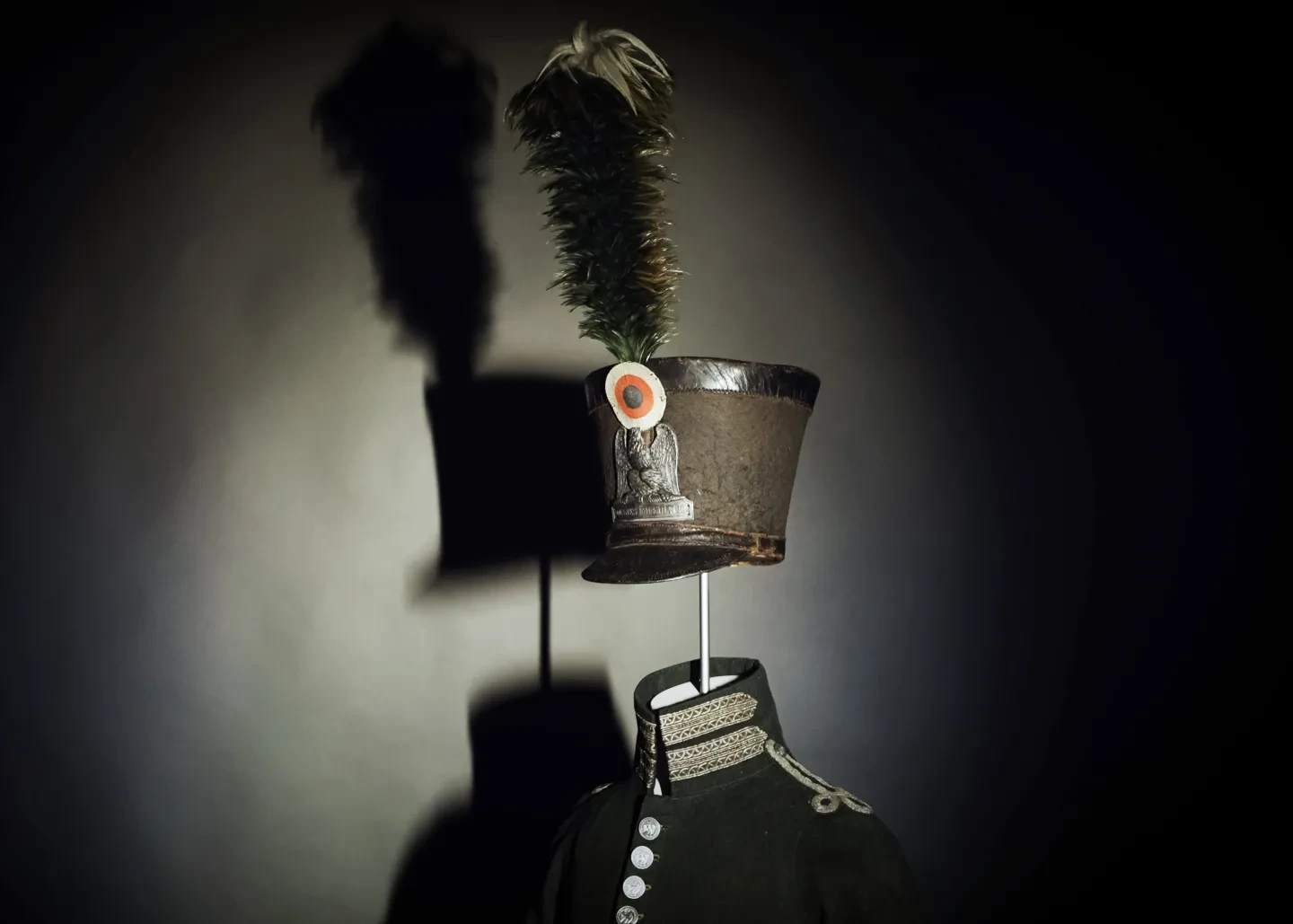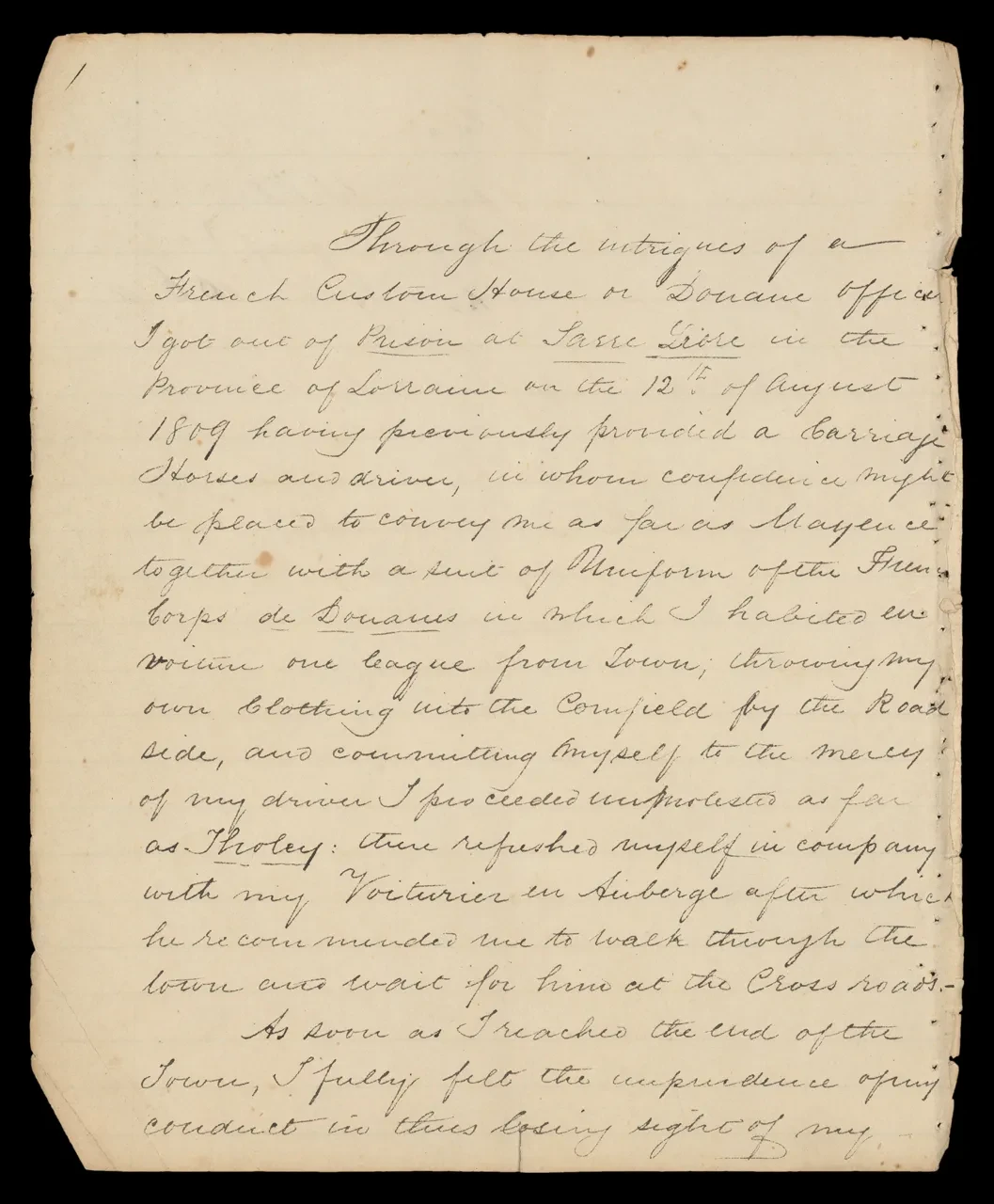Recently Discovered Uniform Goes On Display At The National Maritime Museum

The National Maritime Museum, Greenwich has acquired a rare and very special uniform and manuscript from the descendants of a former Naval Midshipman called Charles Hare. Hare was a teenage prisoner in Napoleonic France who successfully escaped by disguising himself as an officer in the French Imperial Customs Service (Les Douanes). This never seen before uniform went on display today in the Nelson, Navy, Nation gallery at the National Maritime Museum ahead of Trafalgar Day on Oct 21.
Historians and experts previously had no idea that the uniform and accompanying archival documents existed. For generations, these extraordinary artefacts were the treasured possessions of Hare’s descendants, until the family decided to offer them to the National Maritime Museum, allowing their ancestor’s remarkable story to be shared with the world. They had taken excellent care of the uniform, which remains in good condition despite its age. Now, following conservation treatment from the team at the Museum, it is ready to be seen by the public for the first time. What makes it all the more special is that the uniform is the most complete surviving example of its type from the Napoleonic era.
Katherine Gazzard, Curator of Art at the National Maritime Museum said: ‘There were important changes in how prisoners of war were treated during the Napoleonic Wars. Captured British soldiers and sailors were forced to spend years in French custody. Some attempted to escape by disguising themselves as farm workers and laundrywomen, but Hare is the only individual we know of who impersonated a French officer. This may be because it was an exceptionally dangerous thing to do – if caught, he would have been executed as a spy. He must have been very brave.’

An extract from Hare’s firsthand written narrative which was acquired with the uniform reads:
‘If taken in a military habit, bearing arms or false papers, instant death awaits me by the decrees of Bonaparte; the violation of which I fully knew.
This horrible idea striking forcibly on my imagination probably caused an air of distraction in my countenance. Standing listening with ardent anxiety for the rattling of my carriage, I perceived myself much noticed by passengers; every minute increasing my suspicion, it nearly amounted to the rash determination of making the best use of my strength by instant flight.’
The uniform consists of a dark green coat with stripes of silver lace at the collar. Eagles are stamped on the buttons of the coat, together with an all-seeing eye and the words, ‘Douanes Imperiales’. These words are repeated on a belt buckle and a hat from the same uniform. Part of the uniform is a shako, a type of military cap characterised by its tall and cylindrical shape – with a leather peak and a soaring plume of green and white feathers.
The archival material acquired with the uniform includes a blow-by-blow account of his escape. Written in Hare’s own words, this account charts every leg of his journey, gives an insight into his anxieties and fears, includes his jokes (often at the expense of the French) and concludes with the story of his pet dog, who accompanied him the whole way through his ordeal.
Hare’s dog proved to be a vital companion and ally along his harrowing escape.
A further extract from Hare’s narrative reads:
‘I cannot conclude without acquainting my friends the readers, that I was accompanied by an English Terrier dog given me by a Gentleman at Verdun four years before, I found him of the greatest use on my journey for whenever an unpleasant question was addressed to me at supper or other times by inquisitive people I figured not to hear them and kept continually caressing and noticing my Dog; which stratagem never failed to succeed from the extreme politeness of a Frenchman seeing me more interested with my dog than with his intruding conversation.’
In late August 1809, six years after being captured by the French, Hare eventually managed to return home to his beloved family in Lincolnshire and was greeted by his mother and sisters.
Timeline of the Great Escape:
28 September 1789 Charles Hare is born in Fillingham, Lincolnshire. His father, also called Charles Hare, is a naval officer.
1801 Charles Hare joins the Royal Navy, aged eleven. His father dies in the same year.
1803 The French capture the Minerve, the ship in which Hare was serving, off Cherbourg. All hands are taken to the POW depot at Verdun. The officers, Hare included, live in the town on parole.
1806 Hare is transferred from Verdun to the prison fortress at Sarre Libre (Saarlouis).
12 August 1809 Hare escapes from the prison fortress at Sarre Libre. He travels by carriage to Mainz, before proceeding along the Rhine in a series of boats, eventually reaching Rotterdam.
25 August 1809 Hare presents himself on board the Royal Oak, a British warship blockading the Dutch coast. A few days later, he sails back to Britain, arriving first at Great Yarmouth, then proceeding north to Grimsby.
Late August 1809 Hare arrives at his home in Summer Castle, Lincolnshire, having walked from Grimsby. He is greeted by his mother and sisters.
Katherine Gazzard, Curator of Art at the National Maritime Museum said: ‘Thanks to films like The Great Escape, many people today are familiar with the ingenuity and courage of prisoners in the Second World War. However, Charles Hare is proof that there are incredible prisoner-of-war stories from earlier conflicts too – and the survival of the uniform that he used in his escape really brings to life his remarkable journey from captivity to freedom. Thanks to Hare’s descendants, who kept the uniform safe for generations, we are now able to share his story with the world. I’m delighted people will be able to come along to the museum and see it for themselves.’
For those interested in hearing a more detailed account of Hare’s ‘Great Escape’, Dan Snow’s History Hit released a programme on History Hit TV on October 18 and a podcast dedicated to the story on October 21.
Dan Snow said, ‘This is an absolutely amazing discovery revealing one of the most exciting unknown stories from the Napoleonic Wars, giving a rare insight into the human stories behind one of history's most tumultuous conflicts. It was a thrill to get the History Hit Team involved and help bring this story to life for the first time. I can’t wait to share it with our audience.’
More information can also be found on the website, rmg.co.uk.
The National Maritime Museum is open daily from 10am to 5pm.
Ends
Interviews with our curators regarding the Hare story can be allocated upon request.
Images to the uniform, conservation in progress shots and archival material can also be requested.
Notes to editors
The National Maritime Museum holds the world’s largest maritime collection telling stories of Britain’s relationship with the sea.
The National Maritime Museum holds a vast collection of historic uniforms, including more than 7,000 items of regulation dress, sailors’ clothing, ceremonial attire and accessories from the British Royal Navy.
The National Maritime Museum is part of Royal Museums Greenwich which also incorporates the 17th-century Queen’s House, Royal Observatory Greenwich and the famous clipper ship Cutty Sark. This unique collection of museums and heritage buildings form a key part of the Maritime Greenwich UNESCO World Heritage Site and is also a major centre of education and research. The mission of Royal Museums Greenwich is to enrich people’s understanding of the sea, the exploration of space, and Britain's role in world history. For more information, visit rmg.co.uk.
ABOUT HISTORY HIT
History Hit, the podcast, SVOD and content platform founded by historian Dan Snow and acquired by award-winning content studio and digital media network Little Dot Studios, is a premium media network focused on making history more accessible in the digital age. History Hit, its SVOD service, was launched in November 2017, focusing on original history programming aimed at an audience that loves real history. The channel covers history across the globe - notable recent expeditions have included Jordan, China and Peru as well as popular British subjects such as Anne Boleyn and Richard III. New stories are frequently broken on History Hit TV, from the discovery of Thomas Cromwell's long-lost prayerbook, to an Anglo Saxon warriors' cemetery and the forgotten skeletons of the Battle of Waterloo. With over 750 documentaries, interviews and hundreds of original films, History Hit TV won the Best Specialist Channel for two consecutive years at the 2023 and 2024 Broadcast Digital Awards. History Hit also works as a production company, in the last 3 years making 15 films presented by Dan Snow for Channel 5. The podcast arm of the media network publishes eight hugely successful podcast series, including the chart-topping Dan Snow's History Hit, which publishes three times a week. Other podcasts within their network include bi-weekly shows Betwixt the Sheets with Kate Lister and American History Hit with Don Wildman. The network publishes 16 podcast episodes a week for enthusiasts of all eras, from ancient times to present day and won the silver award for Best Network at the 2023 British Podcast Awards. Leveraging Little Dot Studios’ content management, acquisition and distribution expertise, History Hit has grown its social media platforms by more than 2.5 million followers, and launched a FAST channel across all major streaming platforms in 2022. Additionally, the History Hit YouTube Channel offers up to three new releases each week that feature prominent figures and significant topics from the history world. The channel boasts a diverse array of original formats, including Who Was The First?, Historical Google Questions, Could You Survive?, and in-house produced historical movie reviews. Garnering an impressive 7 million views per month and over 1.5 million hours of content consumed monthly, History Hit continues to captivate and educate its growing audience.
For further information or images, please contact: press@rmg.co.uk | 020 8312 6789